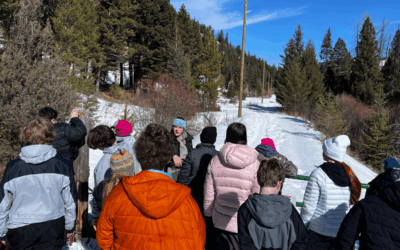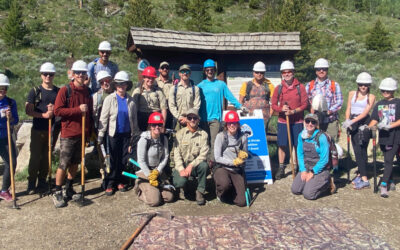By Valerie Manne
My husband Mitch and I moved to Butte, Montana, a little over two years ago. We were excited to see we’d be moving to a city surrounded by so much National Forest land. When we arrived here and before we were even settled, we wanted to hit the trails. I searched for hikes online and there were only two trails listed in our closest mountain range on a popular hiking trail website. This didn’t make a lot of sense to us. We were moving from the Adirondacks in northern New York, where almost every hike could be searched and read about on online. Trailheads had their own parking lots with trailhead kiosks and registry boxes. There were deluxe National Geographic maps to cover the entire Adirondack boundary. It was easy to find a hike and set out for the day. It didn’t take us long before we realized we needed to research quite a bit more before exploring our new backyard. We put together this article for those who may want to learn a thing or two about hiking in Montana.
You’ll want a high clearance vehicle
We moved to Montana with a Subaru Crosstrek and Impreza. We were confident that our Crosstrek’s high clearance would be enough for getting around and accessing hiking trails. The hiking access we were used to was always off of well-maintained roads. It didn’t take long for us to realize the need for a high clearance truck (just one summer season). Most of the hiking trails we have mapped on our website are accessed from Forest Service roads. These roads aren’t maintained very often and it’s common to encounter sharp jagged rocks of all sizes and tire eating potholes. Two of the closest CDT access points from Butte, Nez Perce Road and Homestake Trailhead, are accessible on well-maintained roads, but if you plan on getting to some of the more remote hiking areas, it’s best to either rent a high clearance vehicle, have a friend with one, or buy your own.
You need to be bear aware
Southwest Montana has two types of bears: black bears and grizzly bears. Each bear has unique characteristics and behaviors. You can learn about the differences in behaviors by watching this video by Park Wildlife Biologist John Waller. We’d also suggest learning how to distinguish physical characteristics between the two by reading this pamphlet by Montana Fish and Wildlife. If you plan on hiking in Montana, make sure you are prepared with bear spray. You can find these in many local stores including Bob Wards, Three Bears, REI, and most other outdoor stores in Montana. If you’re not familiar with bear safety, we suggest you also read our article, Tips for Hiking in Montana’s Bear Country, before heading out.
There isn’t always a technical map for the range you are hiking
When we realized we were moving to Butte, we were ecstatic seeing we were about to be surrounded by so much public land. I suppose we assumed there were trails all throughout the National Forests, which there are. We just couldn’t find them online easily. We were also having a hard time finding maps of the surrounding forests that included all the info we were interested in, like topographic lines, mileage, and shaded relief. There are some older Forest Service maps, but the information is outdated and they don’t typically include mileage. It took some hunting, but after a few years we found a couple cartographers that have some maps of the nearby ranges. These maps aren’t always found in local outdoor stores, and while you can find full maps for the CDT (such as CDTC’s map set) one of our favorite ranges, the Pioneer Mountains still doesn’t have a complete map.
You won’t be able to get into the higher trails during winter
As we mentioned before, most of the hikes we have on our website are accessed by Forest Service roads. These roads aren’t maintained for winter and aren’t the easiest to get to even in summer. Since many of these access roads aren’t plowed, you could expect to add a good 10+ miles to reach the actual trailhead in the winter. There are a few exceptions to this rule, such as hikes that are fairly close to nearby towns, but the majority of the trails we hike aren’t accessible in the winter. The only other way to reach these trailheads during the winter months is by using a winter specific motorized vehicle. This is why most of the hikes we highlight on our website are suggested for late spring – autumn. Something to keep in mind and research if you plan on winter hiking in Montana!
Mountain weather can be drastically different than down in the valleys
If you’re new to hiking, this is something to consider and prepare for. Back in our college days while attending a meteorology class, we discovered a rule of thumb which estimates that for every 1,000 feet you ascend, the temperature drops 3.5-5 degrees F. Therefore the temperature for where you’re hiking can be much cooler than your home base down in a valley. Mountain weather is also notorious for being unpredictable. Mountain ranges create their own weather patterns. For example, we noticed in the spring that clouds get hung up and the mountains are more likely to have thunderstorms while our home city has blue skies. Always be prepared – check the weather for where you’re hiking, pack for the unpredictable, and stay safe.
Not all trails are well-marked
We realized pretty quickly that we needed to do a lot more research before setting out to hike in Montana. For example, some trails may not have a trailhead kiosk which makes it hard to know when you have arrived at the trailhead destination. We’ve also noted some trails have intersections without directional signs or they may list a trail number instead of listing your destination which can be confusing. Additionally, some trails that exist on maps don’t actually exist anymore. We’ve learned it’s best to take into account as many different sources to determine the trail you’ll take (Google satellite, maps, GPS).
Wherever you are hiking, being prepared is what keeps you safe and helps make your experience a positive one. We’ve fully enjoyed this new approach to hiking. It makes the experience feel more rugged and remote. It feels like more of an adventure. We hope you are lucky enough to have the experience of hiking in Montana too.
Valerie Manne is the founder of Backyardmontana.com, which aims to improve online trail information in Southwest Montana. She’s committed to exploring the trails near her home in Butte, Montana, and sharing that knowledge with others.



